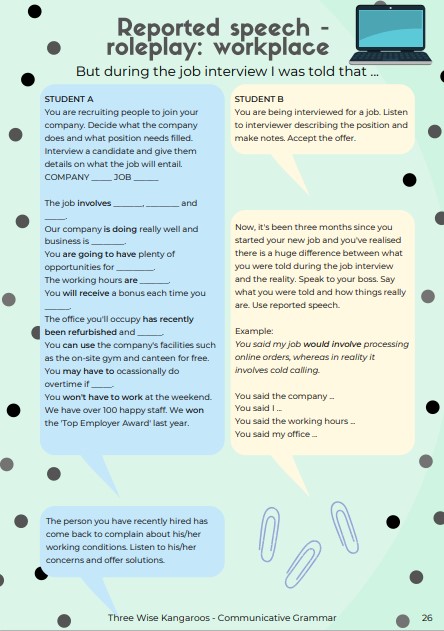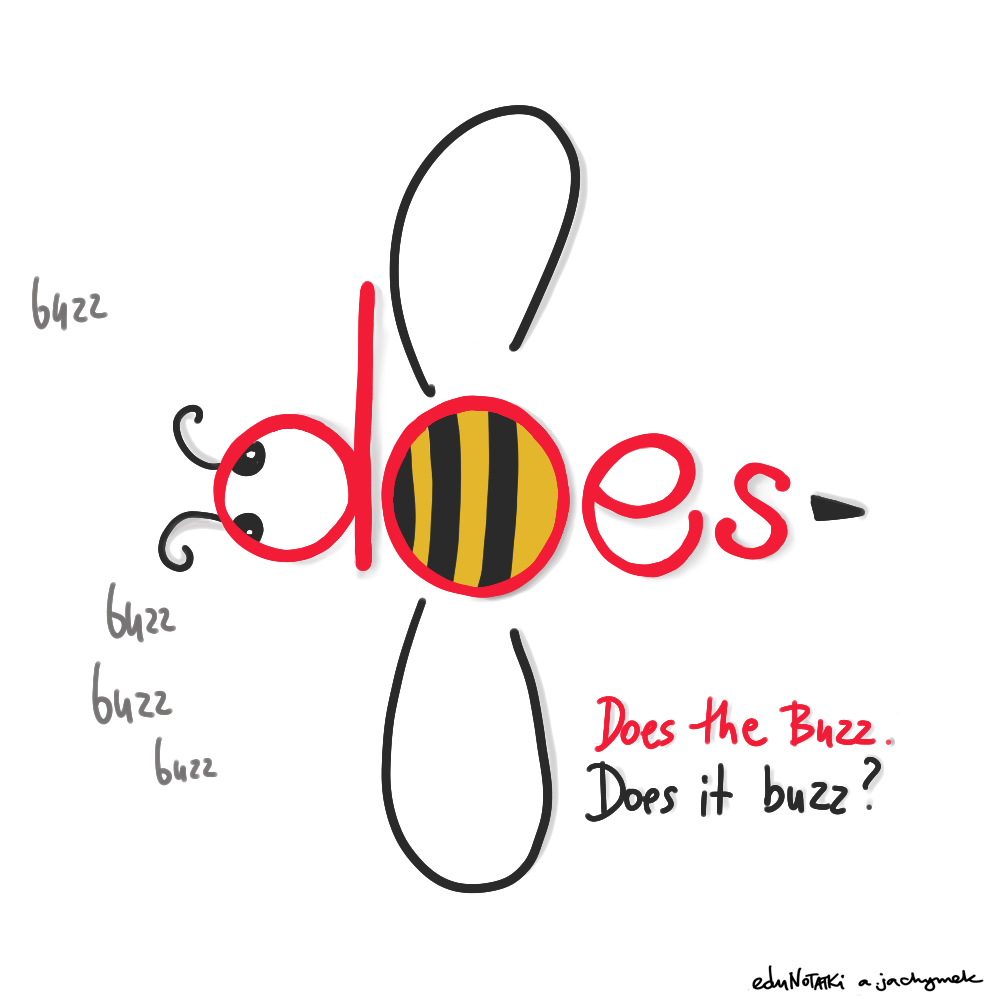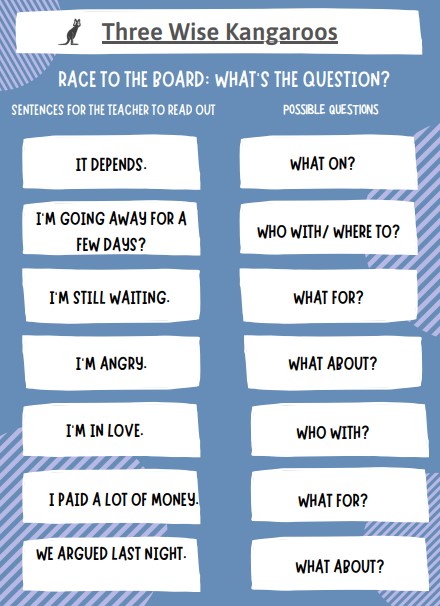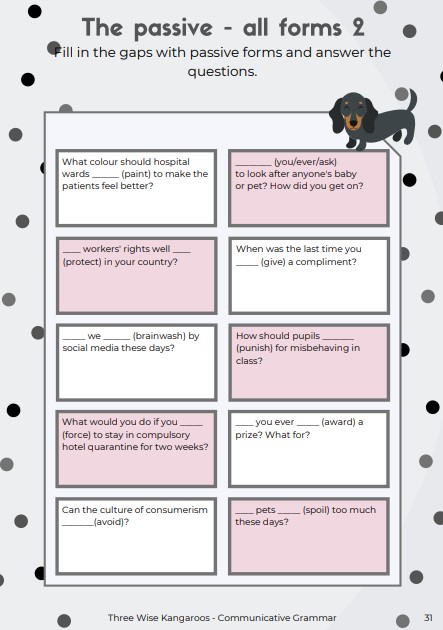It goes without saying that grammar is part and parcel of the language thanks to which we can communicate messages precisely and accurately. However, a lot of students find grammar an unattractive concept in itself and often associate it with the tedious act of studying grammar rules and gap-filling generic sentences. The truth is, though, that grammar can be taught and practised in fun, engaging ways and here are 11 ideas how.
1. Drills
Drills are great in that they reinforce the target structures through exposure and repetition. They are great for group classes, especially at lower levels or when a particular grammar point has just been introduced and the students need to get more familiar with the structure. As a teacher, start with your own example and ask the students to apply the same structure and complete the sentence with their own ideas.
I _______ yesterday, but I didn’t ______ yesterday.
My mum always ______, but she never ______ in the morning.
I’m good at ______, but I’m not so good at ______.
The students are likely to remember the structure for two reasons. One – they will hear this drill repeated many times, and two – it refers to their personal experience.
2. Grammar auction

Who doesn’t like activities that involve competition and money? Grammar auctions tick all the boxes for a great whole-class activity. Simply divide your students into groups and present them with the Grammar auction sheet. They will find in it 20 sentences, some of which are incorrect. Their task is to bet money on each sentence (between $10 and $100) and determine which sentences are correct and which are not. If their answer is right, they gain the money they bet. If it’s not, they lose it. The winning team is the one with the biggest profit/ smaller loss in the end. The worksheet below is a mix of various grammar structures and can be used with your B2/C1 students but there are many more grammar auction worksheets available online and I also encourage you to make your own based on whatever grammar points you have been discussing in class.
Download Grammar Auction together with the answer key here:
This content is available to registered users only.
Register or log in now.
3. Songs
There are certain elusive structures in English that even my advanced students often make mistakes with. First conditional is an example of such a structure. Raise your hand if you’ve never heard your students say Let’s have a picnic when the weather will improve. Or I’ll call you when I will be in town. My recipe for recurring mistakes with troublesome structures is to play a song and have a gap fill activity that focuses on the structure in questions. Songs are fun, enjoyed by most students and catchy so if you choose your song wisely, you can really help your students finally remember those pesky rules.
For the first condition we usually do a song by Avici called Wake Me Up. The chorus goes:
So wake me up when it’s all over; when I’m wiser and I’m older.
After that it’s enough for me to just hum the tune in class and my learners know exactly what I’m hinting at. Try Nickelback’s If Everyone Cared or Snow Patrol’s Chasing Cars for second conditional structures, Bryan Adams’ Summer of ‘69 for past tenses, Twenty One Pilots’ Stressed Out for wishes and Pet Shop Boys’ Love etc. for modal verbs. Again, the internet is your best friend for more songs with more grammar points to practise.
4. Practising grammar through speaking
If you have students who are allergic to the very word ‘grammar’ and just love to talk in class but still need to improve their accuracy there is a happy medium. Our latest e-book Communicative Grammar is brimming with ideas for communicative classes centred around various grammar points. It’s a 100% practical approach to grammar but your students won’t even notice it’s grammar they are practising!
It features over 500 questions and covers most points of English grammar. It was designed with the student in mind to include up-to-date content and topics everyone can relate to. You can access the full description here. Click the preview to see the contents and sample pages. You’ll also be pleased to know Communicative Grammar is now available 20% cheaper so why not grab yourself a bargain and save a ton of time lesson planning?
You can buy Communicative Grammar ebook here.
5. Writing
Assigning written tasks is a great way of putting your students’ grammar to the test. It’s not just about practising one grammar structure but consolidating all the grammar together with vocabulary, spelling, format, register and punctuation and making it fit the purpose. Giving your students a written assignment regularly is a brilliant way of keeping their progress on track but if you’re lacking ideas for topics, here’s a bunch:
6. Spinning a yarn
I’m sure you’ve had your students tell a story in writing, but have you had them do it orally. Here’s one of my favourite methods for practising relative clauses through oral storytelling.
Cut up the pages below and put the relative clauses in a hat or a box. Sit your students in a circle. Start the story. It can be something like, ‘We were all sitting in our living room playing Monopoly when we heard this strange noise coming from the outside.’ Pick one card from the hat/box and continue the story till you can incorporate the card in it, e.g. ‘At first we thought it came from our next door neighbour who often tested his new inventions in his garage.’ Pass the hat on to the first student. They must take another card and continue the story while trying to use another relative clause. The student doesn’t have to use the relative clause in the first sentence they say. They simply continue the story till they can fit the relative clause in. If they are lost for ideas or use the relative clause in an illogical or incorrect way, they must stand up and the next student takes over. The winner is whoever stays sitting down and this person is offered a prize (usually five extra points in their next text ;-)) I can assure you the best ever stories are born this way and you will be surprised how creative your students can get. I’ve ended up with perfect scripts for romantic comedies as well as blood-curdling thrillers. Barrels of laughs guaranteed.
Of course, relative pronouns are just an example. You can use verbs, prepositions, quantifiers, adverbs or anything else that can become building blocks for a story.
 |
 |
Download Relative clauses story bits here:
This content is available to registered users only.
Register or log in now.
7. Gaming
I am a big fan of playing games in class and over time have accumulated quite a collection of various board and card games – both store-bought and made by me. For those who prefer digital resources, there is a plethora of tools to choose from too. Here’s a bunch of websites that combine gaming and learning grammar:
https://freerice.com/categories/english-grammar
The last page allows you to kill two birds with one stone – practise your grammar while making a difference in the world. Following the description on the page, ‘Freerice is an educational trivia game that helps you get smarter while making a difference for people around the world. Every question you answer correctly raises 10 grains of rice for the World Food Programme (WFP) to support its work saving and changing lives around the world. ‘
8. Would I lie to you?
If your students still need to master the art of asking questions then you must try out Would I Lie to You? I’ve already elaborated on why it is so brilliant and how to incorporate it into your class in a separate post which you can access here:
Suffice to say, it is tonnes of fun for the students and the teacher and I recommend it wholeheartedly.
9. Roleplays

I have a perfect example from my own experience to illustrate how roleplays are great grammar practice and how pragmatic they are too. One day I was having a one-on-one lesson with a student who told me she wasn’t happy in her new job. She said things didn’t quite work out as she had expected because what she was told during the job interview was a far cry from the reality she found in her office. She wanted me to help her prepare for her confrontation with her boss and we roleplayed the scenario which was a perfect opportunity to practise reported speech. I was the boss who had promised her a pie in the sky during the job interview which never eventuated and she was the disappointed employee reminding me what I promised/said/assured her about and how different the reality turned out to be. In fact I included the prompts for that roleplay in my Communicative Grammar. Have a look.
You can buy Communicative Grammar ebook here.
10. Mnemonics
A lot of people remember things better when they are illustrated with pictures or reinforced with a catchy rhyme and grammar is no exception. Get your students to get creative and come up with their own ideas for presenting those tricky grammar rules and you could even hold a contest for the best mnemonic.

The image of the bee courtesy of Agnieszka Jachymek – www.edunotatki.pl
11. Students like to move it, move it
As teachers we must be aware of various learning styles we encounter in class. Some learn best by seeing, some by hearing, some by having a hands-on experience and some by combining the three and we must make sure we cater for everybody. Kinesthetic students learn by touching, doing and moving around and it’s important to include activities that involve the said actions while practising grammar. Here’s one way loved by my students.
Type a few sentences (depending on what grammar point has been the focus in class) in a big font, print them out and cut them up. While you cut up the sentences into chunks, make sure you don’t mix up the sentences. Divide the students into teams. Give each team member a sentence chunk and ask them to recreate the whole sentence by lining up in the correct order. Make sure each team has the same sentence to put together. The fastest team or the team which completes the task correctly scores a point.

Another activity which also requires a good reflex is Race to the board. Make sure you clear the centre of the classroom area to allow enough space for the race which actually involves running. Print out the questions making sure they are big enough for everyone to be able to see from a distance. Stick the questions in random order on your whiteboard with some bluetack. Divide your students into two teams and get both teams to line up. Get them to stand a few metres from the board. Read the first sentence from the worksheet. The students must then choose the correct question for the statement, run to the board and tap the correct answer. The fastest tap scores a point. The students take turns at running till all the cards run out. Mind you, sometimes more than one answer is correct and the teacher must assess the student’s choice.
Download Race to the board here:
This content is available to registered users only.
Register or log in now.
A variation of this game can involve tapping the correct past form of tricky regular and irregular verbs. You will find many of the verbs listed here:
I hope you’ve been inspired.
Happy teaching and till next time!
Gaby
If you liked the post, please share it with your friends on social media.




